engine Alfa Romeo 166 2007 Owner handbook (in English)
[x] Cancel search | Manufacturer: ALFA ROMEO, Model Year: 2007, Model line: 166, Model: Alfa Romeo 166 2007Pages: 272, PDF Size: 4.17 MB
Page 128 of 272

127
AUTOMATIC FUEL CUT-OFF SWITCH
The car is equipped with a safety switch
which is triggered in the event of a crash
to interrupt the flow of fuel and stopping
the engine as a consequence. This also
prevents fuel leaks due to fuel lines
breaking.If no leaks or damages to electric de-
vices (e.g.: headlights) are found and the
car can be restarted, reactivate the fuel
cut-off switch. Follow the instructions giv-
en below.
If, after an accident, you
can smell petrol or see
that the fuel feed system is leak-
ing, do not reset the switches to
avoid the risk of fire.
WARNING
After the crash, remember to turn the ig-
nition key to STOPto prevent the bat-
tery running down.
Page 130 of 272

129
ENVIRONMENTAL
PROTECTION
The design and construction of the vehi-
cle have not only been developed with
the traditional aspects of performance
and safety in mind but also take into ac-
count the increasingly pressing problems
tied to protecting the environment.
The choice of materials, techniques and
particular devices are the result of work
which has made it possible to drastically
reduce the harmful effects on the environ-
ment and guarantee respect for the sever-
est international norms.
USE OF NON-TOXIC
MATERIALS
None of the components of the vehicle
contain asbestos. The padding and the cli-
mate control system do not contain CFCs
which are held to be responsible for the
destruction of the ozone layer.
The colouring agents and the corrosion
inhibitors used on the nuts, screws and
bolts do not contain cadmium or chrome
which could pollute the atmosphere or
water tables.
EMISSION REDUCING DEVICES
(Petrol engines)
Catalysts
The exhaust system is fitted with a sys-
tem of catalysts formed of precious metal
alloys housed in a stainless steel contain-
er which withstand high operating tem-
peratures.
The catalysts convert unburned hydro-
carbons, carbon monoxide and nitric ox-
ides in the exhaust gas (even in minimal
quantity, thanks to the electronic ignition
and injection systems) into non polluting
compounds.
Page 131 of 272
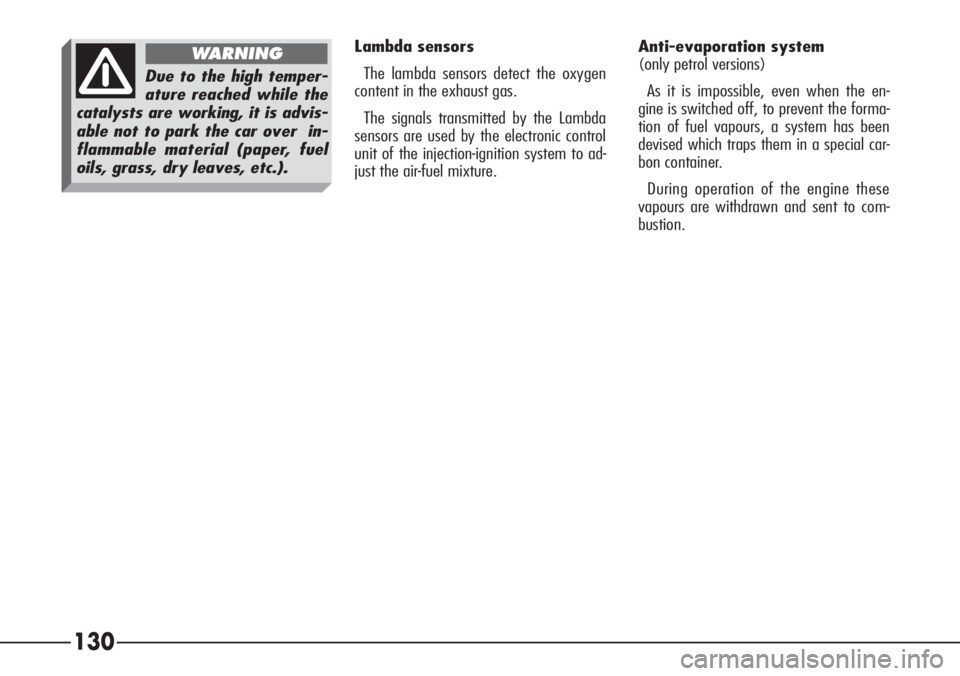
130
Lambda sensors
The lambda sensors detect the oxygen
content in the exhaust gas.
The signals transmitted by the Lambda
sensors are used by the electronic control
unit of the injection-ignition system to ad-
just the air-fuel mixture.Anti-evaporation system
(only petrol versions)
As it is impossible, even when the en-
gine is switched off, to prevent the forma-
tion of fuel vapours, a system has been
devised which traps them in a special car-
bon container.
During operation of the engine these
vapours are withdrawn and sent to com-
bustion.
Due to the high temper-
ature reached while the
catalysts are working, it is advis-
able not to park the car over in-
flammable material (paper, fuel
oils, grass, dry leaves, etc.).
WARNING
Page 132 of 272

131
EMISSION REDUCING DEVICES
(diesel engines)
Oxidising catalytic converter
Converts the polluting substance in the
exhaust gases (carbon monoxide, un-
burnt hydrocarbons and particulate), thus
reducing the fumes and smell that are
typical of diesel engines.
The catalytic converter consists of a
stainless steel case that houses a ceramic
honeycomb coated with noble metal used
as a catalyst.Exhaust gas recirculation system
(E.G.R.)
This system recycles, i.e. re-uses, a
varying percentage of the exhaust gases
depending on engine operating condi-
tions.
It is used, when necessary, to control ni-
tric oxides.
Page 134 of 272
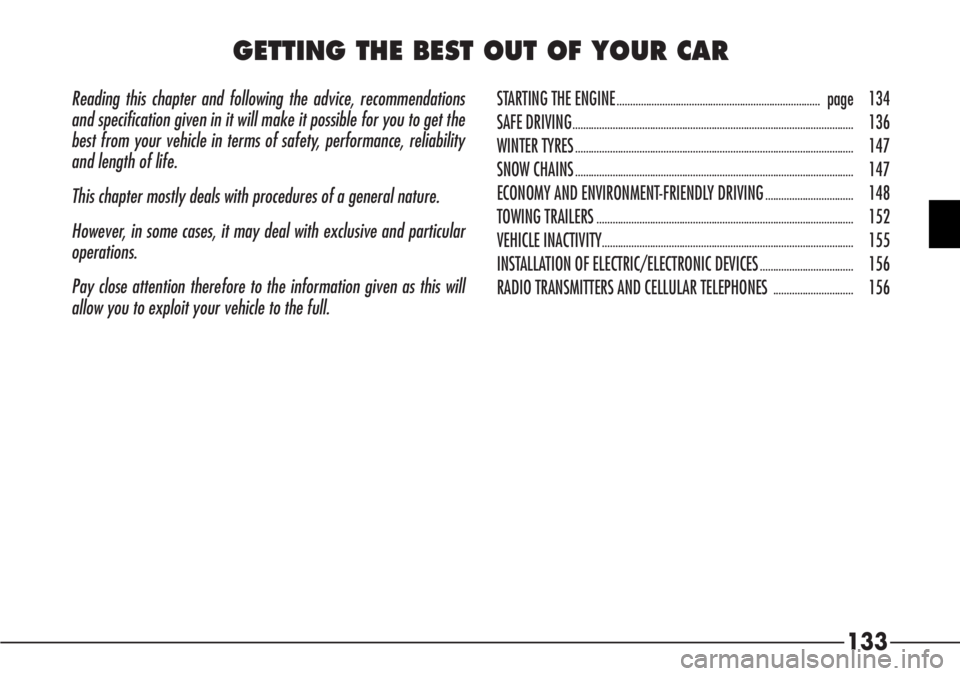
133
Reading this chapter and following the advice, recommendations
and specification given in it will make it possible for you to get the
best from your vehicle in terms of safety, performance, reliability
and length of life.
This chapter mostly deals with procedures of a general nature.
However, in some cases, it may deal with exclusive and particular
operations.
Pay close attention therefore to the information given as this will
allow you to exploit your vehicle to the full.STARTING THE ENGINE............................................................................page 134
SAFE DRIVING
.........................................................................................................136
WINTER TYRES
........................................................................................................147
SNOW CHAINS
........................................................................................................147
ECONOMY AND ENVIRONMENT-FRIENDLY DRIVING
.................................148
TOWING TRAILERS
................................................................................................152
VEHICLE INACTIVITY
..............................................................................................155
INSTALLATION OF ELECTRIC/ELECTRONIC DEVICES
...................................156
RADIO TRANSMITTERS AND CELLULAR TELEPHONES
..............................156
GETTING THE BEST OUT OF YOUR CAR
Page 135 of 272

134
In addition to the notes
and specifications given
below we recommend
that, during the initial period, y-
ou do not drive to full vehicle
performance (for example exces-
sive acceleration, long journeys
at top speed, hard braking etc.).
STARTING
THE ENGINE
IMPORTANT The car is fitted with an
electronic engine lock device. if the en-
gine fails to start see “The Alfa Romeo
CODE system”.The ignition switch is fitted with a safety
device which obliges the driver to return
the ignition key to the STOPposition be-
fore repeating the starting operation if
the engine does not start immediately.
Similarly, when the engine is running,
the device prevents the key being moved
fromMARto the AVV position.
PROCEDURE FOR PETROL
ENGINES
With cold engine:
1) Engage the handbrake.
2) Ensure that the systems and electri-
cal devices, especially if they absorb high
quantities of energy (e.g. heated rear
windscreen), are switched off.
3) Set the gearshift lever to neutral and
fully depress the clutch without pressing
the accelerator.
4) Turn the ignition key to the AVV posi-
tion releasing it as soon as the engine starts.
Never leave the ignition
key in the MAR position
when the engine is
switched off.
5) If the engine does not start immedi-
ately, return the key to the STOPposi-
tion and repeat the operation
With hot engine:
1) Engage the handbrake.
2) Ensure that the systems and electri-
cal devices, especially if they absorb high
quantities of energy (e.g. heated rear
windscreen), are switched off.
3) Set the gearshift lever to neutral and
fully depress the clutch without pressing
the accelerator.
4) Turn the ignition key to the AVV posi-
tion releasing it as soon as the engine starts.
5) If the engine does not start immedi-
ately, return the key to the STOPposition
and repeat the procedure, slightly pressing
the accelerator pedal without pumping it.
Running the engine in
confined areas is ex-
tremely dangerous. The engine
consumes oxygen and produces
carbon monoxide which is a highly
toxic and lethal gas.
WARNING
Page 136 of 272
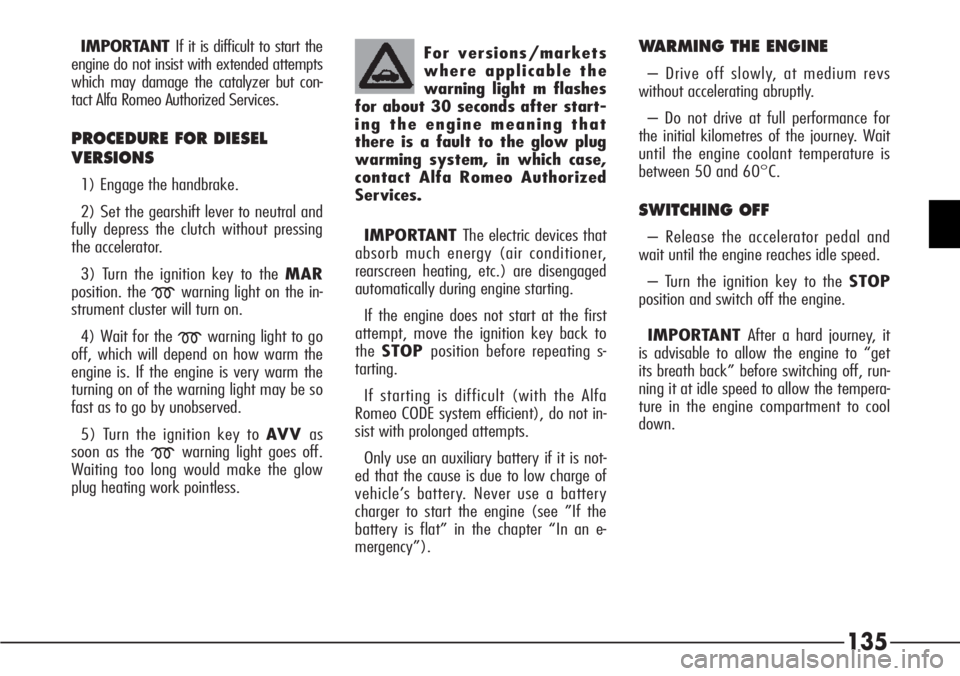
135
IMPORTANT If it is difficult to start the
engine do not insist with extended attempts
which may damage the catalyzer but con-
tact Alfa Romeo Authorized Services.
PROCEDURE FOR DIESEL
VERSIONS
1) Engage the handbrake.
2) Set the gearshift lever to neutral and
fully depress the clutch without pressing
the accelerator.
3) Turn the ignition key to the MAR
position. the
mwarning light on the in-
strument cluster will turn on.
4) Wait for the
mwarning light to go
off, which will depend on how warm the
engine is. If the engine is very warm the
turning on of the warning light may be so
fast as to go by unobserved.
5) Turn the ignition key to AVV as
soon as the
mwarning light goes off.
Waiting too long would make the glow
plug heating work pointless.IMPORTANT The electric devices that
absorb much energy (air conditioner,
rearscreen heating, etc.) are disengaged
automatically during engine starting.
If the engine does not start at the first
attempt, move the ignition key back to
theSTOPposition before repeating s-
tarting.
If starting is difficult (with the Alfa
Romeo CODE system efficient), do not in-
sist with prolonged attempts.
Only use an auxiliary battery if it is not-
ed that the cause is due to low charge of
vehicle’s battery. Never use a battery
charger to start the engine (see ”If the
battery is flat” in the chapter “In an e-
mergency”).
WARMING THE ENGINE
– Drive off slowly, at medium revs
without accelerating abruptly.
– Do not drive at full performance for
the initial kilometres of the journey. Wait
until the engine coolant temperature is
between 50 and 60°C.
SWITCHING OFF
– Release the accelerator pedal and
wait until the engine reaches idle speed.
– Turn the ignition key to the STOP
position and switch off the engine.
IMPORTANT After a hard journey, it
is advisable to allow the engine to “get
its breath back” before switching off, run-
ning it at idle speed to allow the tempera-
ture in the engine compartment to cool
down. For versions/markets
where applicable the
warning light m flashes
for about 30 seconds after start-
ing the engine meaning that
there is a fault to the glow plug
warming system, in which case,
contact Alfa Romeo Authorized
Services.
Page 137 of 272
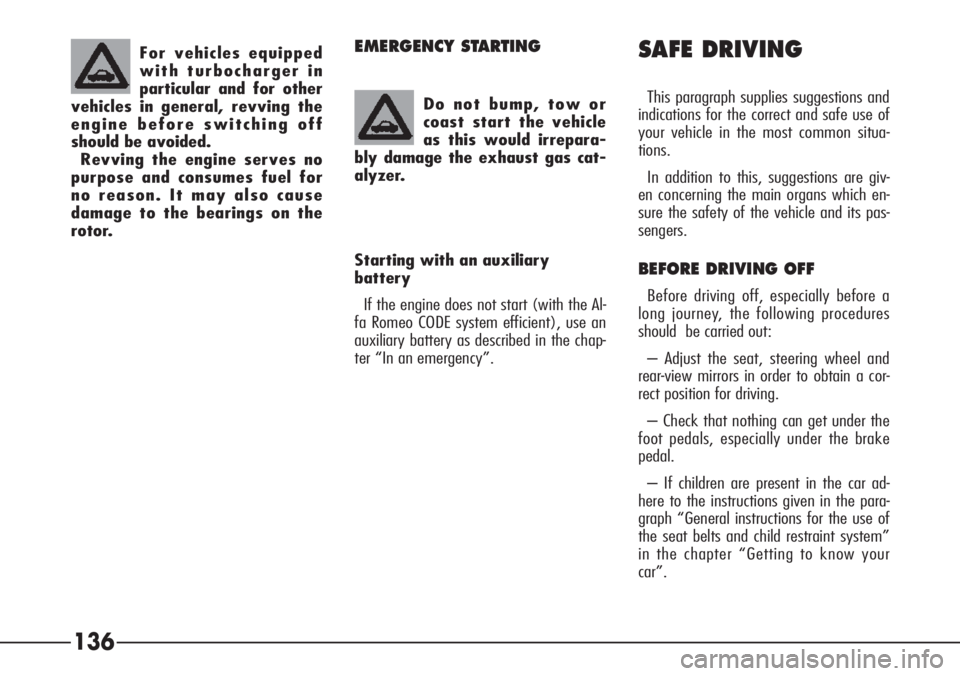
136
EMERGENCY STARTING
Starting with an auxiliary
battery
If the engine does not start (with the Al-
fa Romeo CODE system efficient), use an
auxiliary battery as described in the chap-
ter “In an emergency”.
SAFE DRIVING
This paragraph supplies suggestions and
indications for the correct and safe use of
your vehicle in the most common situa-
tions.
In addition to this, suggestions are giv-
en concerning the main organs which en-
sure the safety of the vehicle and its pas-
sengers.
BEFORE DRIVING OFF
Before driving off, especially before a
long journey, the following procedures
should be carried out:
– Adjust the seat, steering wheel and
rear-view mirrors in order to obtain a cor-
rect position for driving.
– Check that nothing can get under the
foot pedals, especially under the brake
pedal.
– If children are present in the car ad-
here to the instructions given in the para-
graph “General instructions for the use of
the seat belts and child restraint system”
in the chapter “Getting to know your
car”. For vehicles equipped
with turbocharger in
particular and for other
vehicles in general, revving the
engine before switching off
should be avoided.
Revving the engine serves no
purpose and consumes fuel for
no reason. It may also cause
damage to the bearings on the
rotor.
Do not bump, tow or
coast start the vehicle
as this would irrepara-
bly damage the exhaust gas cat-
alyzer.
Page 139 of 272
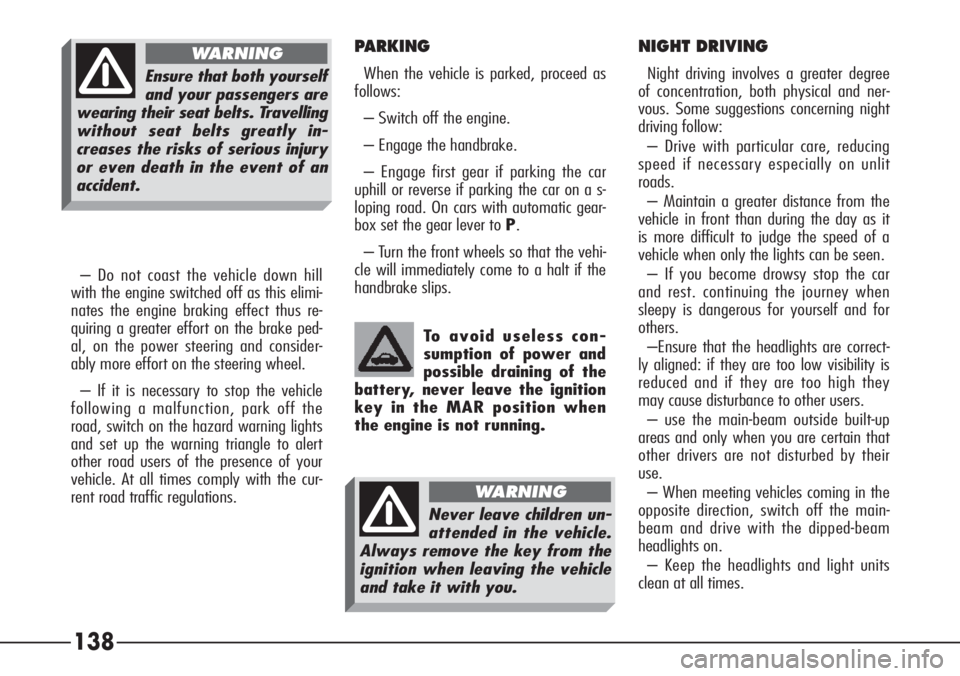
138
PARKING
When the vehicle is parked, proceed as
follows:
– Switch off the engine.
– Engage the handbrake.
– Engage first gear if parking the car
uphill or reverse if parking the car on a s-
loping road. On cars with automatic gear-
box set the gear lever to P.
– Turn the front wheels so that the vehi-
cle will immediately come to a halt if the
handbrake slips.
NIGHT DRIVING
Night driving involves a greater degree
of concentration, both physical and ner-
vous. Some suggestions concerning night
driving follow:
– Drive with particular care, reducing
speed if necessary especially on unlit
roads.
– Maintain a greater distance from the
vehicle in front than during the day as it
is more difficult to judge the speed of a
vehicle when only the lights can be seen.
– If you become drowsy stop the car
and rest. continuing the journey when
sleepy is dangerous for yourself and for
others.
–Ensure that the headlights are correct-
ly aligned: if they are too low visibility is
reduced and if they are too high they
may cause disturbance to other users.
– use the main-beam outside built-up
areas and only when you are certain that
other drivers are not disturbed by their
use.
– When meeting vehicles coming in the
opposite direction, switch off the main-
beam and drive with the dipped-beam
headlights on.
– Keep the headlights and light units
clean at all times. – Do not coast the vehicle down hill
with the engine switched off as this elimi-
nates the engine braking effect thus re-
quiring a greater effort on the brake ped-
al, on the power steering and consider-
ably more effort on the steering wheel.
– If it is necessary to stop the vehicle
following a malfunction, park off the
road, switch on the hazard warning lights
and set up the warning triangle to alert
other road users of the presence of your
vehicle. At all times comply with the cur-
rent road traffic regulations.To avoid useless con-
sumption of power and
possible draining of the
battery, never leave the ignition
key in the MAR position when
the engine is not running.Ensure that both yourself
and your passengers are
wearing their seat belts. Travelling
without seat belts greatly in-
creases the risks of serious injury
or even death in the event of an
accident.
WARNING
Never leave children un-
attended in the vehicle.
Always remove the key from the
ignition when leaving the vehicle
and take it with you.
WARNING
Page 140 of 272
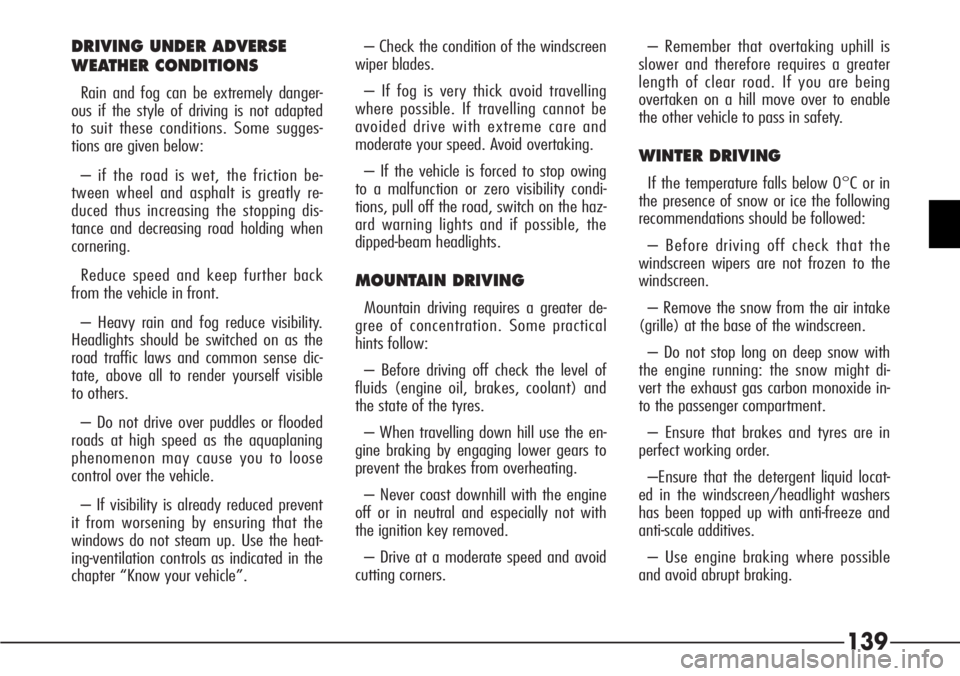
139
DRIVING UNDER ADVERSE
WEATHER CONDITIONS
Rain and fog can be extremely danger-
ous if the style of driving is not adapted
to suit these conditions. Some sugges-
tions are given below:
– if the road is wet, the friction be-
tween wheel and asphalt is greatly re-
duced thus increasing the stopping dis-
tance and decreasing road holding when
cornering.
Reduce speed and keep further back
from the vehicle in front.
– Heavy rain and fog reduce visibility.
Headlights should be switched on as the
road traffic laws and common sense dic-
tate, above all to render yourself visible
to others.
– Do not drive over puddles or flooded
roads at high speed as the aquaplaning
phenomenon may cause you to loose
control over the vehicle.
– If visibility is already reduced prevent
it from worsening by ensuring that the
windows do not steam up. Use the heat-
ing-ventilation controls as indicated in the
chapter “Know your vehicle”.– Check the condition of the windscreen
wiper blades.
– If fog is very thick avoid travelling
where possible. If travelling cannot be
avoided drive with extreme care and
moderate your speed. Avoid overtaking.
– If the vehicle is forced to stop owing
to a malfunction or zero visibility condi-
tions, pull off the road, switch on the haz-
ard warning lights and if possible, the
dipped-beam headlights.
MOUNTAIN DRIVING
Mountain driving requires a greater de-
gree of concentration. Some practical
hints follow:
– Before driving off check the level of
fluids (engine oil, brakes, coolant) and
the state of the tyres.
– When travelling down hill use the en-
gine braking by engaging lower gears to
prevent the brakes from overheating.
– Never coast downhill with the engine
off or in neutral and especially not with
the ignition key removed.
– Drive at a moderate speed and avoid
cutting corners.– Remember that overtaking uphill is
slower and therefore requires a greater
length of clear road. If you are being
overtaken on a hill move over to enable
the other vehicle to pass in safety.
WINTER DRIVING
If the temperature falls below 0°C or in
the presence of snow or ice the following
recommendations should be followed:
– Before driving off check that the
windscreen wipers are not frozen to the
windscreen.
– Remove the snow from the air intake
(grille) at the base of the windscreen.
– Do not stop long on deep snow with
the engine running: the snow might di-
vert the exhaust gas carbon monoxide in-
to the passenger compartment.
– Ensure that brakes and tyres are in
perfect working order.
–Ensure that the detergent liquid locat-
ed in the windscreen/headlight washers
has been topped up with anti-freeze and
anti-scale additives.
– Use engine braking where possible
and avoid abrupt braking.